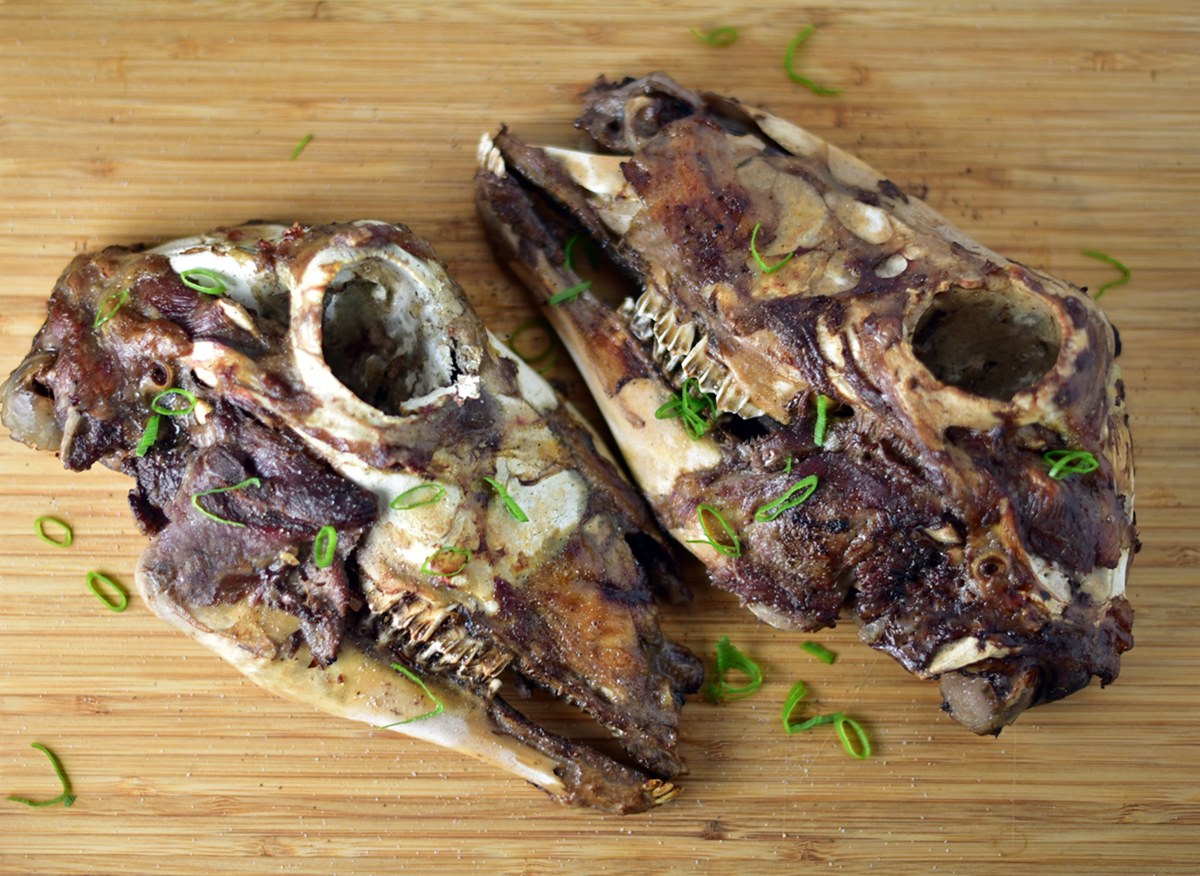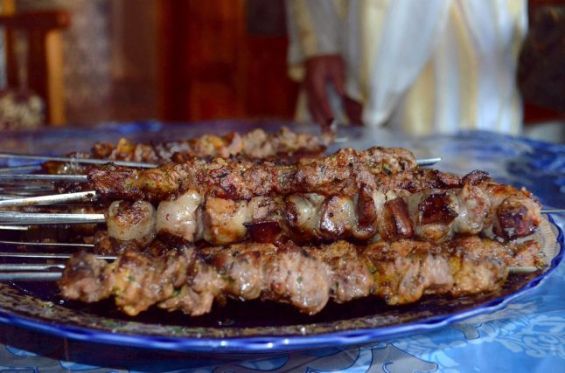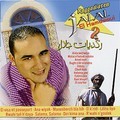As Muslims worldwide celebrate Eid al-Adha, carrying out the sacrificial ritual, Moroccan families gather for a feast steeped in tradition. These dishes, passed down through generations, showcase the rich tapestry of Moroccan cuisine. While regional variations exist, these five iconic plates are guaranteed to grace Moroccan tables during Eid al-Adha. Let's embark on a culinary journey to discover them!
Boulfaf: The Star of the Show
Eid al-Adha is a bustling affair. After early morning prayers, Moroccans return home for the Udhiya, the ritual sacrifice. Following this family endeavor, often involving the slaughtering of a sheep, comes a well-deserved reward: Boulfaf. This star dish, aptly named «the rolled one» in Arabic, features skewered liver pieces wrapped in fresh sheep caul fat. Prepared soon after the sacrifice, the liver is cooked and becomes an integral part of the Eid experience.

A 1958 cookbook by Zette Guinaudeau-Franc, a French writer who spent 50 years collecting traditional Moroccan recipes in Fez, offers an original recipe for this Eid al-Adha specialty. The liver is quickly grilled until browned, then cut into half-inch cubes. The freshly extracted sheep caul fat is cut into long strips and soaked in warm water if needed for easier handling.
Here comes the fun part! The liver cubes are seasoned with salt, cumin, and a touch of red pepper before being rolled in the caul fat strips. Secured on metal skewers, the Boulfaf is grilled a second time and then enjoyed with Morocco's signature beverage - mint tea.
Mrouzia: Sweet and savory harmony
Mrouzia, a signature Moroccan dish marrying sweet and savory flavors, takes center stage during Eid al-Adha. While some regions enjoy it to conclude the seven-day Eid celebrations, others savor it within the first two days.
Mrouzia, or M'assal in Rabat, has long been associated with Eid al-Fitr due to its reliance on lamb meat. Food historian Mohamed Oubahli, in his book on a 19th-century M'alhun poet and his banquet, describes Mrouzia as a «kind of meat jam» served with a dark mahogany-colored sauce. Moroccans prepare mutton with grated onions, dried fruit (raisins, prunes, figs, or dates), blanched almonds or walnuts, and honey. The dish is seasoned with aromatics like ginger, cinnamon, saffron, black pepper, and a blend of spices known as Ras el hanout or Liqama d'almrouzia (in Marrakesh).

Traditionally slow-cooked over two to three hours, Mrouzia begins with marinating bone-in mutton in a spice mixture called «Tarkida» the day before. Moroccans use cuts like collar, shoulder, saddle, ribs, tendons, knuckles, or leg. The first stage involves simmering the meat and onions with spices in a large broth. Once the meat is nearly cooked and the broth reduces, raisins, honey, and cinnamon are introduced.
The final flourish comes in the form of almonds - boiled with the meat or browned in butter - added just before serving for an extra touch of elegance.
Hergma: A celebration of texture and flavor
Following the home slaughter, Moroccans turn their attention to another Eid delicacy - Hergma. This dish exemplifies the diversity of Moroccan cuisine and the dedication poured into these festive meals.
Hergma, also known as Frakech or Kour3ine (meaning «trotters»), is a slow-cooked stew featuring lamb trotters, chickpeas, and sometimes wheat berries. During Eid, families come together to enjoy this dish, as a single lamb's feet wouldn't create a substantial meaty offering. However, the true charm of Hergma lies in the «tendons, fat, and connective tissue around the joints», which, as Taste of Morocco writes, «are flavorful thickeners for the sauce» - hence the inclusion of chickpeas and wheat berries.
.jpg)
Hergma boasts a thick, sticky sauce due to the gelatin released from the trotters during slow cooking. In cities like Marrakesh, these trotters are simmered overnight in ashes with a clay urn-shaped pot, known as a qaloucha or tanjia.
Some food enthusiasts link Hergma to the Moroccan Jewish community, suggesting it might be a cousin of Dafina or Sakhina, a «spicy-sweet stew traditionally cooked on the Sabbath with calves' feet and tongue, dumplings, and dates». Some variations of Hergma incorporate this sweet and savory element by replacing chickpeas and wheat with rice and figs.
Guedid: Preserving the bounty
While Eid al-Adha is a time for families to gather and enjoy delicious meals, Moroccans also take this opportunity to preserve some of the sacrificed lamb for future enjoyment. Long before the invention of refrigerators, Moroccans perfected their own method of drying meat - a centuries-old tradition called Guedid.
During Eid al-Adha, families select cuts of meat or ribs from the slaughtered lamb and prepare them for drying using the power of sunshine, a constant companion in Morocco. The traditional method involves seasoning the meat with salt, garlic, coriander, and cumin. For a touch of color, some may add turmeric or sweet chili pepper.
Once seasoned, the meat is meticulously hung in a dry, clean, and, most importantly, sunny area of the house, typically the terrace or patio. As Moroccan cook Choumicha notes in an online recipe, Guedid's preparation «requires patience and care».

She further elaborates, «It has become a highly prized delicacy, and its mythical, meticulous, and slow preparation takes place especially during Eid Al Kabir, when meat is plentiful». The dried Guedid is then stored and used throughout the year, particularly in winter dishes like those featuring lentils, beans, and couscous.
Guedid also forms the base for another delightful dish called Khelii. This involves marinating the dried meat in oil and fat, creating a delicious treat often enjoyed with eggs.
Couscous with lamb head: A bold Eid tradition
Eid al-Adha also provides an opportunity for adventurous eaters to explore unique culinary experiences. While lamb feet might seem unusual, in Morocco, the adventurous spirit extends to another part of the animal - the head.
On the first Friday following Eid, many Moroccan families prepare the head of the slaughtered sheep using their national dish, couscous. The preparation is quite straightforward: vegetables are cooked as usual, but instead of meat or chicken, the lamb head takes center stage. A cookbook describes this dish as «strong and smart».

The lamb head is first grilled over charcoal, then soaked in water, divided in two, and meticulously cleaned. Finally, it is simmered with vegetables and the couscous stew. The cookbook also highlights the «meaty» lamb tongue and, interestingly, notes that in Fez, the «eyes are considered the best part and plucked and handed to the guest of honor».
And you? What is the Eid al-Adha special dish you are most excited to feast on?





 chargement...
chargement...













